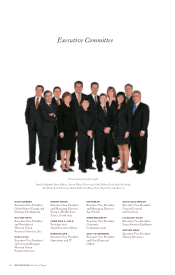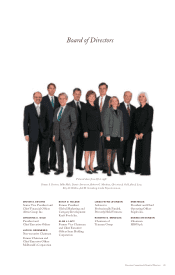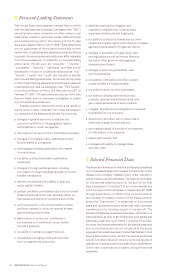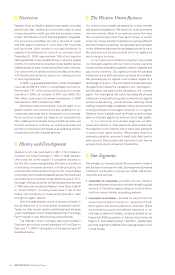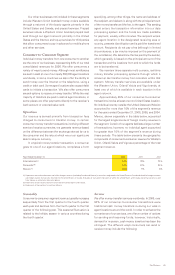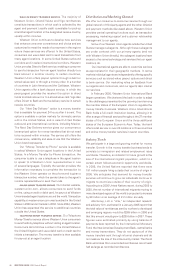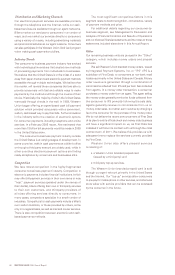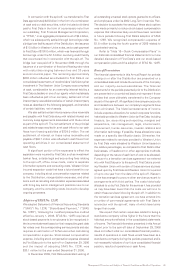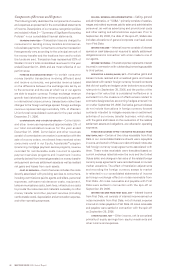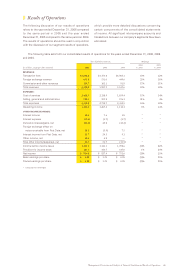Western Union 2006 Annual Report Download - page 39
Download and view the complete annual report
Please find page 39 of the 2006 Western Union annual report below. You can navigate through the pages in the report by either clicking on the pages listed below, or by using the keyword search tool below to find specific information within the annual report.37 Our Business
In 2006, consumers transferred $53 billion in consumer-
to-consumer transactions through our company in both cross-
border and intra-country transactions. Funds transferred
through our agent network have increased at a compound
annual growth rate of 26% from 2004 to 2006.
Another significant trend impacting the money transfer
industry is the increase in regulation in recent years.
Regulation in the United States and elsewhere focuses,
in part, on anti-money laundering and anti-terrorist financing
compliance efforts. Regulations require money transfer
providers, banks and other financial institutions, to develop
systems to monitor and report appropriately on certain
transactions.
Competition
We face robust competition in the highly-fragmented
consumer-to-consumer money transfer industry. We
compete with a variety of money transfer service
providers, including:
|| GLOBAL MONEY TRANSFER PROVIDERS
—
Global money transfer
providers allow consumers to send money to a wide
variety of locations, in both their home countries
and abroad.
|| REGIONAL MONEY TRANSFER PROVIDERS
—
Regional money
transfer companies, or “niche” players, provide the same
services as global money transfer providers, but focus
on a small group of corridors or services within one
region, such as North America to the Caribbean, Central
or South America, or western Europe to north Africa.
|| BANKS
—
Banks of all sizes compete with us in a number
of ways, including bank wire services and card-based
services. We believe that banks often use wire transfer
services and other money transfer methods to attract
immigrant consumers to their banks so they can sell
them other services and products.
|| INFORMAL NETWORKS
—
Informal networks enable people
to transfer funds without formal mechanisms, such as
receipts, and, often, without compliance with government
reporting requirements.
|| ALTERNATIVE CHANNELS
—
Alternative channels, including
mail and commercial courier services, online money
transfer services that allow consumers to send money
over the Internet and card-based options, such as ATM
cards and stored-value cards, allow consumers to send
or receive money.
The most significant competitive factors in consumer-
to-consumer remittances relate to brand recognition,
distribution network, consumer experience and price.
For additional details regarding our consumer-to-
consumer segment, including financial information regarding
our international and United States operations, see
Management’s Discussion and Analysis of Financial
Condition and Results of Operations and our financial
statements and the notes to those statements included
elsewhere in this Annual Report.
Consumer-to-Business Segment
We provide a portfolio of electronic and cash payment
options that provide consumers with fast and convenient
ways to make one-time or recurring payments. These
services facilitate payments to a variety of organizations
that receive consumer payments including utilities, auto
finance companies, mortgage servicers, financial service
providers and governmental agencies which we sometimes
refer to as “billers.” Revenues from this segment represented
14% of our revenue in 2006.
Operations
Our revenue in this segment is derived primarily from
transaction fees paid by the consumer or the biller. These
fees are typically less than the fees charged in our consumer-
to-consumer segment. In order to make an electronic
payment, the consumer or biller initiates a transaction over
the telephone or the Internet which we process using the
consumer’s credit card, debit card or bank account (processed
through the ACH). In order to make a cash payment, the
consumer goes to an agent location and makes the payment
to the agent. While we continue to pursue international
expansion of our offerings in select markets, such as the
December 2006 acquisition of SEPSA, substantially all of
the segment’s 2006 revenue was generated in the United
States. No individual biller accounted for greater than 10%
of this segment’s revenue during all periods presented.
Services
Our consumer-to-business services strive to give consumers
choices as to the payment channel and method of payment,
and include the following:
ELECTRONIC PAYMENTS.
Consumers and billers use our
Speedpay service in the United States and the United
Kingdom to make consumer payments to a variety of billers
using credit cards, debit cards and ACH. Payments are
initiated over the telephone or the Internet.
Our Equity Accelerator
®
service is provided in the
mortgage service industry, enabling consumers to make
mortgage payments by ACH. It is marketed as a convenient
way for homeowners to schedule additional recurring
principal payments on their mortgages. Consumers enroll
in the service, customize their payment schedule and make
payments through one or more bank accounts.
CASH PAYMENTS.
Consumers use our Quick Collect
service to send guaranteed funds to businesses and
government agencies from over 50,000 Western Union
agent locations across the United States and Canada, using
cash and, in select locations, a debit card. Consumers use
our Convenience Pay service to send payments by cash
or check from a smaller number of Convenience Pay agent
locations primarily to utilities and telecommunication
providers. We also offer Quick Cash, a cash disbursement
service used by businesses and government agencies to
send money to employees or individuals with whom they
have accounts or other business relationships. In addition,
our recent acquisition, SEPSA, provides a walk-in bill
payment service in Argentina and operates under the
well-known Pago Fácil brand.





